
Content
- Steps
- Method 1 of 3: Catching the mouse
- Method 2 of 3: Preparing the mouse cage
- Method 3 of 3: Taking care of your mouse
- Tips
- Warnings
- What do you need
- Catching the mouse
- Preparing the mouse cage
- Mouse Care
Many breed ornamental house mice that are easy to care for, but you can also catch and keep a wild mouse in your home. Wild mice can carry a variety of diseases, such as bubonic plague and rabies, they cannot be tamed to the same degree as domestic mice, and they can experience stress from human interactions. However, you can try to keep a wild mouse in your home if you are allowed to catch and keep wild animals in your area. Catch the mouse humanely, create the right environment for it and take care of it, and you can keep it as a pet!
Steps
Method 1 of 3: Catching the mouse
 1 Set up purchased traps and charge them to catch the mouse in your home. Use peanut butter or strong-smelling cheese as bait. If you see a mouse in the house, set up traps along the walls. Place them parallel to the walls to make it easier for the mice to get into them.
1 Set up purchased traps and charge them to catch the mouse in your home. Use peanut butter or strong-smelling cheese as bait. If you see a mouse in the house, set up traps along the walls. Place them parallel to the walls to make it easier for the mice to get into them. - Humane Mouse Traps can be purchased at your local hardware store.
- If you want to place purchased mousetraps outside your home, place them along walls or wherever you've seen mice.
- Inside the house, you will most likely come across house mice that live for about 9-12 months.
 2 Set up a bucket trap outside your home if you want to catch multiple mice at once. Place a 20-liter bucket outside your home, such as in a barn or garage. Use glue to attach a thick wire to the top edge of the bucket. Glue the paper plate so that ¼ part hangs over the wire, and the other ¾ rest lightly on the edge of the bucket. Place a spoonful of peanut butter on the side of the plate that hangs over the wire. Lean a board against the side of the bucket so that the mouse can reach the plate over it. The mice will try to get the peanut butter and fall into the bucket.
2 Set up a bucket trap outside your home if you want to catch multiple mice at once. Place a 20-liter bucket outside your home, such as in a barn or garage. Use glue to attach a thick wire to the top edge of the bucket. Glue the paper plate so that ¼ part hangs over the wire, and the other ¾ rest lightly on the edge of the bucket. Place a spoonful of peanut butter on the side of the plate that hangs over the wire. Lean a board against the side of the bucket so that the mouse can reach the plate over it. The mice will try to get the peanut butter and fall into the bucket. - Expose the bucket for several days to catch more than one mouse at once.
- Usually on the street you can catch field mice, or voles. They can live up to 4 years.
Advice: punch a hole in the bottom of the Coke can and pass a wire through it. Spread some peanut butter on one side of the jar. The mouse will try to get to the paste, the can will turn, and the animal will fall into the bucket.
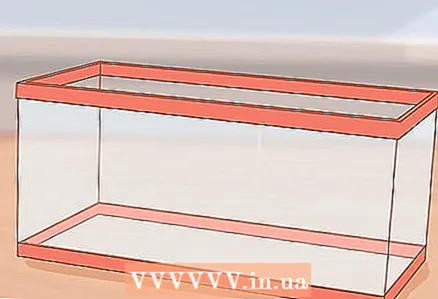 3 Transfer the captured mice to the cage. After you catch the mice, move the trap to the previously prepared cage and carefully release them into it. To release the mice, open a store-bought trap or gently shake them out of the bucket and into the cage.
3 Transfer the captured mice to the cage. After you catch the mice, move the trap to the previously prepared cage and carefully release them into it. To release the mice, open a store-bought trap or gently shake them out of the bucket and into the cage. - Do not try to grab a wild mouse immediately after catching it, as it can bite you out of fear.
 4 If you do need to grasp the mouse with your hands, wear gloves. Wild mice can carry diseases that are dangerous to humans, so wear thick and thick gloves if you need to bring a mouse. To lift the mouse, pass your hand under its body and lightly grab it behind its head so that it cannot slip away.
4 If you do need to grasp the mouse with your hands, wear gloves. Wild mice can carry diseases that are dangerous to humans, so wear thick and thick gloves if you need to bring a mouse. To lift the mouse, pass your hand under its body and lightly grab it behind its head so that it cannot slip away. - Handle the wild mouse as little as possible to reduce the risk of it biting you.
- Never grab the mouse by the tail, as this may cause it to escape.
Method 2 of 3: Preparing the mouse cage
 1 Use a 0.03 cubic meter glass or plastic container for each mouse. For mice, an aquarium-like container with a wire mesh on top is a good choice. Install it in a quiet place away from people and other pets. Make sure it is not exposed to direct sunlight, otherwise it will overheat in warm weather.
1 Use a 0.03 cubic meter glass or plastic container for each mouse. For mice, an aquarium-like container with a wire mesh on top is a good choice. Install it in a quiet place away from people and other pets. Make sure it is not exposed to direct sunlight, otherwise it will overheat in warm weather. - If the wire stack does not fit snugly against the edges of the container, place a stone or a small stack of books on top of it. Ensure that the container is properly ventilated.
 2 Line the bottom of the container with finely chopped paper or wood chips. Place a 5–8 centimeters thick layer of mat on the bottom of the container to keep the mice comfortable. Use shredded paper or aspen sawdust that mice can burrow in.
2 Line the bottom of the container with finely chopped paper or wood chips. Place a 5–8 centimeters thick layer of mat on the bottom of the container to keep the mice comfortable. Use shredded paper or aspen sawdust that mice can burrow in. - Do not use pine or cedar sawdust, as they may contain fumes and oils that are harmful to mice.
 3 Place a saucer for food and water. Place a shallow saucer in an easily accessible part of the container for mice. You can pour water into a small saucer or attach an upside-down water bottle to the side of the container.
3 Place a saucer for food and water. Place a shallow saucer in an easily accessible part of the container for mice. You can pour water into a small saucer or attach an upside-down water bottle to the side of the container.  4 Place a small box and cardboard tubes in a container for mice to hide in. Place a small cardboard box in the corner of the container for the mice to take cover and sleep in. If you are going to keep multiple mice, place another small box or create other dark hiding places with cardboard toilet paper tubes or PVC tubing.
4 Place a small box and cardboard tubes in a container for mice to hide in. Place a small cardboard box in the corner of the container for the mice to take cover and sleep in. If you are going to keep multiple mice, place another small box or create other dark hiding places with cardboard toilet paper tubes or PVC tubing. - Submerge the toilet paper tube in the mat so that only the open ends stick out. This will create a great hiding place for mice.
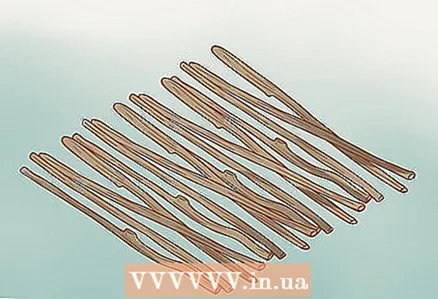 5 Add branches to give the mice something to chew on. Mice need to chew on something as their teeth are constantly growing. Find a thick, hard branch and place it in a container.
5 Add branches to give the mice something to chew on. Mice need to chew on something as their teeth are constantly growing. Find a thick, hard branch and place it in a container. - Do not use pesticide-treated branches as they can harm the mice.
- Make sure that the branch does not reach the top edge of the container, otherwise mice can climb over it and escape.
- You can also buy rodent gummies at the pet store.
Method 3 of 3: Taking care of your mouse
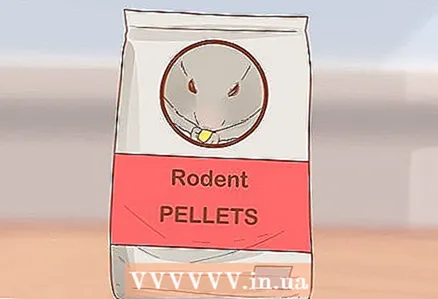 1 Feed your mice rodent pellets and fresh fruits and vegetables. Purchase a bag of rodent pellets from the pet store to balance your pet's diet. If you want to give him fresh food as well, cut the fruits and vegetables into 1.5–2 centimeter cubes and place them in the food saucer. Make sure there is always food in the saucer.
1 Feed your mice rodent pellets and fresh fruits and vegetables. Purchase a bag of rodent pellets from the pet store to balance your pet's diet. If you want to give him fresh food as well, cut the fruits and vegetables into 1.5–2 centimeter cubes and place them in the food saucer. Make sure there is always food in the saucer. - You can try giving mice vegetables and fruits such as peas, carrots, broccoli, apples, bananas.
- Don't give mice cabbage, corn, onions, chocolate, or junk food.
- Try giving the field mouse sunflower seeds, nuts, and strawberries.
 2 Disinfect the container once a week. Remove the mouse from the cage and transfer it to another plastic container to clean its main dwelling. Remove all litter and wipe the container with clean soap and water. Then add new bedding, fill the saucers with food, and place all items in the container. Then transfer the mouse back to its container.
2 Disinfect the container once a week. Remove the mouse from the cage and transfer it to another plastic container to clean its main dwelling. Remove all litter and wipe the container with clean soap and water. Then add new bedding, fill the saucers with food, and place all items in the container. Then transfer the mouse back to its container. - Mice can jump, so make sure that the depth of the spare plastic container that you transfer them to when cleaning the main container is about 15 centimeters.
- Remove debris from container daily. Remove urine-soaked bedding so that there is no unpleasant odor in the container.
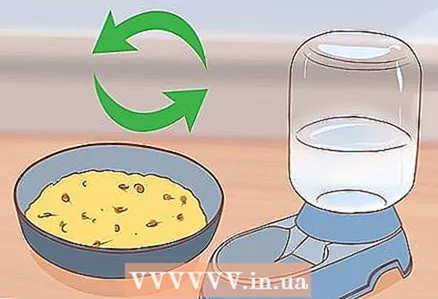 3 Replenish food and water supplies in time. Monitor the amount of food and water in the container and check to see if it starts to deteriorate or rot. If you notice that food or water is running out, clean the appropriate saucer and refill it immediately.
3 Replenish food and water supplies in time. Monitor the amount of food and water in the container and check to see if it starts to deteriorate or rot. If you notice that food or water is running out, clean the appropriate saucer and refill it immediately. - Check food and water daily so that mice don't have to starve or get thirsty.
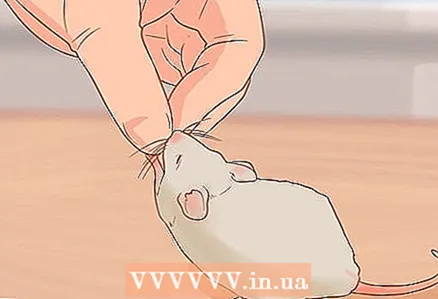 4 Give your mice treats from time to time to tame them. Put on your gloves and grab a tidbit with your fingers. Wait for the mouse to come close to the treat and take it from your hands. At the same time, speak to her in a gentle, quiet voice so that she understands that you will not harm her. Give your mouse a treat 1-2 times a week to get it used to you.
4 Give your mice treats from time to time to tame them. Put on your gloves and grab a tidbit with your fingers. Wait for the mouse to come close to the treat and take it from your hands. At the same time, speak to her in a gentle, quiet voice so that she understands that you will not harm her. Give your mouse a treat 1-2 times a week to get it used to you. - Wild mice can never be tamed as well as domestic ones.
- A rodent treat can be purchased at a pet store.
A warning: mice may try to bite you out of curiosity. Be sure to wear gloves, even if the mouse behaves calmly in your presence.
 5 Separate mice if they are aggressive towards each other. Males usually get along well with each other if kept together from a young age, but feral mice can vie for territory. If you notice that the mice are feuding or one of them is injured, place them in different containers.
5 Separate mice if they are aggressive towards each other. Males usually get along well with each other if kept together from a young age, but feral mice can vie for territory. If you notice that the mice are feuding or one of them is injured, place them in different containers.
Tips
- Get a house mouse if you want to keep it as a pet.
- If you have caught an injured or small mouse, search online for a wildlife rehabilitation specialist near you. The specialist will be able to take care of the animal and leave it.
Warnings
- The presence of humans can be stressful for wild mice. This can make them aggressive (biting attempts) and shorten their lifespan.
- Never keep captured wild mice with house mice. They can behave aggressively or infect domestic mice with various diseases.
- Check if you are allowed to catch and keep wild animals in your area before trying to catch a wild mouse.
- Always wear gloves when handling a wild mouse to prevent it from biting you.
- Wild mice can carry many diseases such as salmonellosis, hantavirus infection, and bubonic plague. Do not try to catch a wild mouse if you are inexperienced with mice.
What do you need
Catching the mouse
- Humane mousetrap
- 20 liter bucket
- Wire
- Paper plate
- Peanut paste
- Heavy Gloves
Preparing the mouse cage
- 0.03 square meter container
- Finely chopped paper or aspen sawdust for bedding
- Rodent food
- Inverted water bottle
- Toilet paper or PVC tubing
- Branch
Mouse Care
- Soap
- Cleaning cloth
- A treat for rodents



